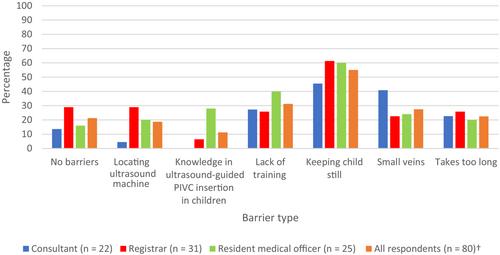A survey of paediatric difficult peripheral intravenous access in the emergency department and use of point-of-care ultrasound
Abstract
Introduction/Purpose
Peripheral intravenous catheter (PIVC) insertion can be challenging in children, with point-of-care ultrasound (POCUS) known to increase success rates. The objective of this study was to survey how emergency department (ED) clinicians identify and escalate paediatric patients with difficult intravenous access (DIVA), specifically the use of POCUS.
Methods
This cross-sectional study was conducted in an Australian academic mixed ED that surveyed resident medical officers (RMOs), registrars, consultants and senior paediatric nurses. A 15 multiple-choice questionnaire evaluated clinicians experience with paediatric PIVC insertion, approach to identifying and managing DIVA and the use of POCUS or other adjuncts.
Results
Eighty clinicians (34.2% response rate) completed the survey. Poor vein palpability was rated the highest predictor of DIVA. Of the respondents, 19 consultants (86.4%), 28 registrars (90.3%) and 16 RMOs (64.0%) used POCUS as an adjunct for paediatric DIVA patients but 16 consultants (72.8%), 21 registrars (67.8%) and 20 RMOs (80.0%) would use this less than 25% of the time in clinical practice.
Discussion
This survey suggests more clinicians to prefer using objective factors when identifying paediatric DIVA patients, rather than subjectively using gestalt, which relies on clinician experience. Whilst clearly recognised as a useful tool in our study, POCUS was used infrequently for paediatric DIVA patients.
Conclusions
There is currently no consistent process for the identification and escalation of paediatric DIVA patients, including the use of adjuncts such as POCUS. Clinician awareness for these issues should be addressed, which should include the development of guidelines and clinician training in POCUS for PIVC insertion in children.


 求助内容:
求助内容: 应助结果提醒方式:
应助结果提醒方式:


